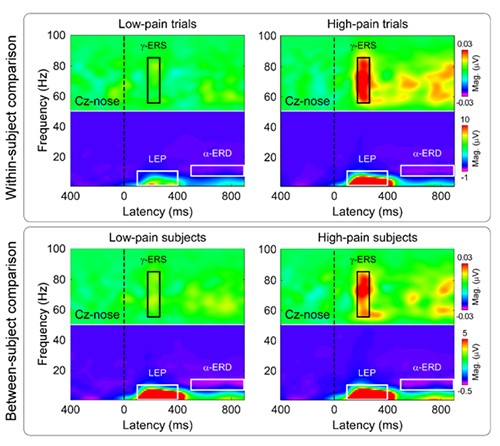
Figure γ-ERS reflected both within- and between-subject variability of pain perception
With the support by the National Natural Science Foundation of China, Prof. Li Hu at the Institute of Psychology, Chinese Academy of Sciences, together with Prof. Giandomenico Iannetti at University College London, demonstrated that brain oscillations in the gamma band [gamma-band event-related synchronization (γ-ERS)] reliably and selectively predict pain sensitivity across individuals. This finding was recently published in PNAS (2019, 116(5): 1782-1791).
Pain perception varies widely among individuals. The same mild nociceptive stimulus may elicit unpredictably intense sensations in someone, yet be barely perceived by another. Such dramatic variability has always been a puzzle and a challenge for pain scientists, due to the huge health and economic burdens of pain and the potential clinical implications of pain sensitivity.
Previous studies have attempted to identify neural markers for the variability of pain sensitivity. However, most studies investigate how the same individual responds to stimuli of different intensities (within-subject variability), not how different individuals respond to stimuli of the same intensity (between-subject variability). A few studies have indeed treated these two sources of variability differently, but the findings are not conclusive.
Overcoming methodological and analytical issues in existing studies, Prof. Hu and Prof. Iannetti used electrophysiology to sample brain activity of humans and rodents, and demonstrated that while many laser-evoked brain measures reflected subjective pain ratings at the within-subject level, only γ-ERS reliably distinguished subjective ratings within the same individual and coded pain sensitivity across different individuals in humans and rats alike. Moreover, the temporal-spectral pattern of γ-ERS response accurately predicted the intensity of pain across subjects. Importantly, γ-ERS did not track the between-subject reported intensity of nonpainful but equally salient auditory, visual, and non-nociceptive somatosensory stimuli. Taken together, these results show that laser-induced gamma oscillations predict pain sensitivity across individuals both reliably and selectively.
This discovery of a neurophysiological trait reflecting cross-individual perceptual variability would shed insight into the mechanisms underlying perceptual and cognitive performance, and is of particular relevance in pain neuroscience where such variability poses significant challenges in clinical practice.

Add: 83 Shuangqing Rd., Haidian District, Beijing, China
Postcode: 100085
Tel: 86-10-62327001
Fax: 86-10-62327004
E-mail: bic@clinicaltrials-nyph.org
京ICP备05002826号 文保网安备1101080035号 Copyright 2017 NSFC, All Right Reserved